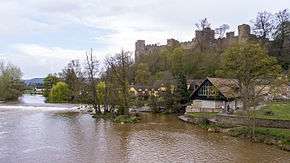Ulmus minor 'Glandulosa'
The Field Elm cultivar Ulmus minor 'Glandulosa' was described as Ulmus glabra [:smooth-leaved] Mill. var. glandulosa by Lindley in A Synopsis of British Flora, arranged according to the Natural Order (1829),[1] from trees near Ludlow, Shropshire. Melville identified a specimen in Ludlow in 1939, calling it in a 1946 paper "a good form of U. carpinifolia" [:U. minor ], describing it more fully and renaming it U. carpinifolia Gled. var. glandulosa (Lindl.). Regarding it as out of its natural range and deliberately planted, he referred to it as The Ludlow Elm, the "type tree" of a "variety" of Field Elm.[2] Herbarium specimens of 'Glandulosa' are held in both the Lindley Herbarium in Cambridge and the Borrer Herbarium at Kew.
| Ulmus minor 'Glandulosa' | |
|---|---|
| Species | Ulmus minor |
| Cultivar | 'Glandulosa' |
| Origin | England |
Ley (1910) noted that other forms of field elm exhibit "the same glandular development, but without the same [leaf-]shape". He considered that "These must probably be placed under var. glandulosa".[3]
Description
Lindley reported the leaves "very glandular beneath".[1] Melville (1946) included an illustration of a natural-size short shoot, with leaves on average 7 × 3 cm, with a slender base to the long side and a long petiole to 12 mm, and gave the following description: "Distal and subdistal leaves of the short shoots narrowly obovate, acute, with greatest breadth about 45% of the lamina length in the distal and 50% in the subdistal leaves; basal half of margin of long side, arched or nearly straight, making a sharp rectangular turn at the base 2–4 mm from the petiole".[2] Ley (1910) added that the leaves are "scabrous and epilose above, pilose beneath".[3]
Pests and diseases
Though susceptible to Dutch Elm Disease, field elms produce suckers and usually survive in this form in their area of origin.
Cultivation
Lindley noted that the tree was cultivated near Ludlow,[1] where Ley in 1910 found "large trees on the terraces, upper and lower, of Ludlow Castle, to the west side",[3][4] and where Melville found an old pollarded specimen in 1939, below the castle ramparts and 100 yards from the bridge. In a Kew herbarium specimen (see 'External links') Melville included a postcard on which he indicated the tree.[2] No old trees survive at Ludlow, but there are (2019) a number of monopolar Ulmus minor root suckers @ 10 m in height, notably devoid of samarae in April, with numerous smaller suckers about them. Ley also verified specimens of var. glandulosa near Lutterworth, Leicestershire.[5]
 The western terraces of Ludlow Castle, where Ley found large specimens of var. glandulosa in 1910
The western terraces of Ludlow Castle, where Ley found large specimens of var. glandulosa in 1910 Same
Same
References
- Lindley, John (1829). A synopsis of the British Flora; arranged according to the Natural Orders. London. pp. 226–227. Retrieved 14 December 2017.
- Melville, Ronald (1946). "Typification and Variation in the Smooth-Leaved Elm, Ulmus carpinifolia Gleditsch". Journal of the Linnean Society of London, Botany. Oxford University Press (OUP). 53 (349): 83–90. doi:10.1111/j.1095-8339.1946.tb00409.x. ISSN 0368-2927.
- Ley, Augustin (1910). "Notes on British elms". Journal of botany, British and foreign. 48: 65–72. Retrieved 8 February 2018.
- herbariaunited.org, herbarium specimen, Ulmus glabra Ley var. glandulosa, Ludlow, A. Ley 1910
- herbariaunited.org, herbarium specimen, Ulmus glabra Ley var. glandulosa, Lutterworth, Leicestershire, 1909, by L. Cumming
External links
- "Ulmus carpinifolia v. glandulosa". Herbarium catalogue. Board of Trustees of the Royal Botanic Gardens, Kew. Retrieved 17 October 2016. With Ludlow postcard showing tree (blue arrow)
- "Ulmus carpinifolia v. glandulosa". Herbarium catalogue. Board of Trustees of the Royal Botanic Gardens, Kew. Retrieved 17 October 2016.
- "Herbarium specimen - L.4214017". Botany catalogues. Naturalis Biodiversity Center. Sheet described as Ulmus carpinifolia var. glandulosa
- "Herbarium specimen - L.1586938". Botany catalogues. Naturalis Biodiversity Center. Sheet described as Ulmus carpinifolia var. glandulosa
- "Herbarium specimen 283234, herbariaunited.org" Sheet described as U. glabra Miller var. glandulosa, from Ludlow, 1910, by Rev. Augustin Ley
- "Herbarium specimen 290634, herbariaunited.org" from Ludlow, 1910, by Rev. Augustin Ley
- "Herbarium specimen 277989, herbariaunited.org" from Lutterworth, Leicestershire, 1909, with letter by L. Cumming
- "Herbarium specimen 286314, herbariaunited.org" from Lutterworth, Leicestershire, 1909, by L. Cumming